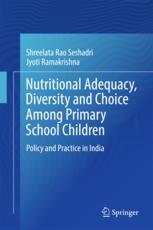

Most ebook files are in PDF format, so you can easily read them using various software such as Foxit Reader or directly on the Google Chrome browser.
Some ebook files are released by publishers in other formats such as .awz, .mobi, .epub, .fb2, etc. You may need to install specific software to read these formats on mobile/PC, such as Calibre.
Please read the tutorial at this link. https://ebooknice.com/page/post?id=faq
We offer FREE conversion to the popular formats you request; however, this may take some time. Therefore, right after payment, please email us, and we will try to provide the service as quickly as possible.
For some exceptional file formats or broken links (if any), please refrain from opening any disputes. Instead, email us first, and we will try to assist within a maximum of 6 hours.
EbookNice Team

Status:
Available4.6
22 reviewsThis book highlights the reality of malnutrition among school-age children in India and relates it with dietary adequacy, diversity and choice. Using empirical data from field research conducted in Karnataka, India, it documents the nutritional status of school-going children, and examines the socio-economic determinants. It provides insights into changing dietary patterns by analysing case studies from households and schools; and documents the impact of changing dietary choices on the daily nutritional intake of young children. As the issue of nutrition for school-age children is one that is largely neglected in the literature, the book fills an important gap.
The book also investigates the policy framework for addressing the nutritional needs of school-going children, and assesses the available government-sponsored interventions in terms of their efficiency and effectiveness, measured by their impact on the nutritional indices of the target group. It offers concrete recommendations for changing the nutritional intake of school-going children. Navigating through the socio-cultural causes for changing food choice and their impact on children’s nutritional outcomes, this book shows a viable path to addressing malnutrition, taking into account both macro-level policy constraints and the micro-level perspectives of families, schools and communities.